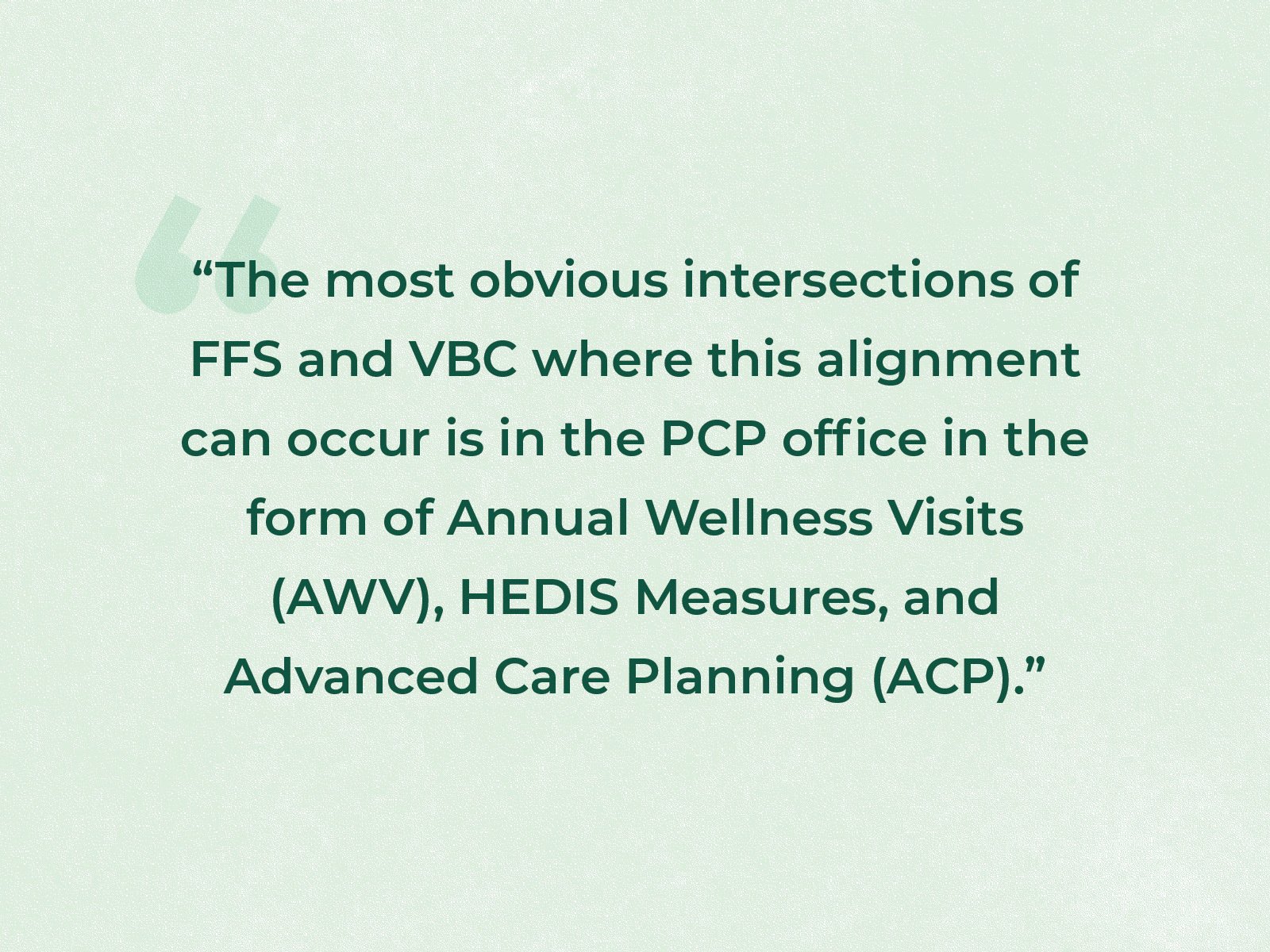The Intersection of FFS and VBC Medicine: Conclusion
As we’ve seen over these past few weeks in our exploration of the intersection of FFS and VBC in the PCP office, the practical application of VBC principles does not need to be an enigma for FFS-heavy practices. You can and, in truth, need to practice in both worlds – FFS and VBC. In fact, VBC concepts applied to non-VBC circumstances can be a boost to FFS healthcare delivery in both revenue and in their transition to practices that create value rather than just creating claims.
The discouraging reality in most organizations is that even in those where VBC revenue leads the way, physician compensation models tend to be either flat salary or FFS revenue- and/or production-based. This can create a disconnect and misalignment of priorities, goals, and incentives between the docs in the trenches and the execs in the board rooms. Recognizing and leveraging the intersections where FFS-driven practices can easily merge into the lanes of VBC can facilitate significant leaps into the VBC space while at the same time supporting their current FFS goals and mindset.
The most obvious intersections of FFS and VBC where this alignment can occur is in the PCP office in the form of Annual Wellness Visits (AWV), HEDIS Measures, and Advanced Care Planning (ACP).
An AWV is a window into the patient’s current state and future risks. What is their current burden of illness? What medications are they on? Which ones do they need to be on? Are they taking their needed meds? Proper prevention and screening for chronic and serious conditions can occur or be initiated in an AWV. Chronic, impactable conditions can be identified in an AWV, so patients can then be directed to the help they need to manage their healthcare journey. Performing the AWV adds revenue and production to the practice. The potential effect on patient care and outcomes that positively impact both the patients’ health and well-being as well as the organization’s opportunity for increased value-based revenue is exponentially higher.
Practices need to pay attention to appropriate HEDIS measures. These activities can improve patient outcomes through prevention and better chronic disease management, reap Pay-for-Performance rewards with payers, and greatly decrease medical expense in long run. The even better news: HEDIS measure closure is a component of an AWV visit, so you shouldn’t need a lot of extra effort for addressing and meeting most.
Palliative Care is gaining the recognition it deserves for appropriately shepherding patients and families through chronic diseases and eventual end of life experiences. The data is clear: proper palliative care in the right circumstances both improves patient quality of life and appropriately decreases medical expense. Advanced Care Planning is both the welcome mat and the doorway to the appropriate utilization of Palliative Care. We’re all going to die, so let’s get on the same page about our priorities in that process.
ACP is probably the most underrated, underutilized tool in a PCP office. We, as physicians, have shown we’re capable of asking the hard questions about substance use and abuse, depression and suicidal ideation, and domestic violence, to name a few. Why not with end of life issues? Unlike substance abuse, depression, suicidal ideation, and domestic violence, we all experience the end of life. Let’s make this an easier, more welcome conversation earlier in people’s journey. (Oh, and bill $85 per ACP at 2.25 RVU and get a VBC revenue ROI of over 5x – see ACP blog.)
To efficiently and effectively do all of this, we need a tool or tools or a platform that brings this information together for use in the PCP practice, both on the day of a scheduled visit and for those patients with needs who don’t have anything scheduled. This is where a lot of practices and organizations struggle. No one has time in today’s PCP office to track down, collect, and organize all the necessary data to see who needs what when.
Tools exist in EMRs and with vendors to aggregate and present this information both at the points of contact and care as well as to administrators for tracking. If you don’t have such a tool or yours isn’t helping you like it should, reach out to us at Affirm Health. We have tools that solve the aggregation, presentation, and analysis issues for practices.
